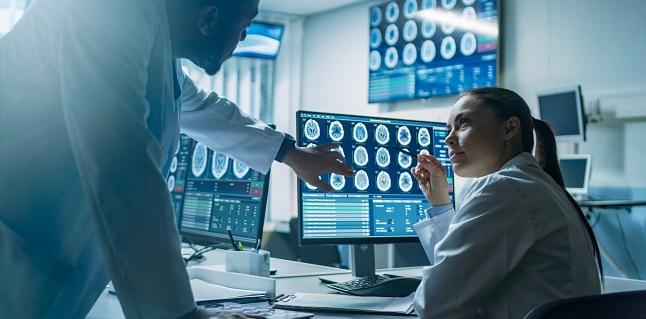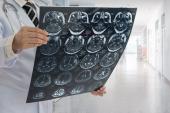Should Cardiologists Be Performing Stroke Thrombectomy?
When cardiologists, neurologists, and radiologists teamed up at one center in Prague, it seemed to work. But skepticism remains.

It’s possible to start a successful stroke thrombectomy program in an experienced cardiac cath lab when cardiologists, neurologists, and radiologists work together closely, the experience at a single center in Prague, Czech Republic, suggests.
In the 7 years after the program launched, the team achieved outcomes similar to those seen in randomized trials conducted at experienced stroke thrombectomy centers, lead author Jakub Sulženko, MD, PhD (Charles University and University Hospital Kralovske Vinohrady), and colleagues report.
A good functional outcome—defined as a modified Rankin Scale (mRS) score of 0 to 2 at 90 days—was observed in 47.9% of patients, right around the 46% rate from a meta-analysis of five randomized stroke thrombectomy trials. There did not appear to be a learning curve.
Looking beyond neurointervention to other specialties as a way to help meet demand for stroke thrombectomy may be a viable option in regions that don’t yet have 24/7 coverage, senior author Petr Widimský, MD, DrSc (Charles University and University Hospital Kralovske Vinohrady), told TCTMD. “A cardiologist could help to fill this gap very quickly if the forces are joined,” he said. “Of course cardiologists cannot do it themselves. You need, always, local agreement between cardiologists, neurologists, and radiologists.”
The neurointerventional community at large has been hesitant to welcome cardiologists into their sphere without years of dedicated training, however.
J Mocco, MD (Mount Sinai Health System, New York, NY), vice president of the Society of NeuroInterventional Surgery, said a physician’s specialty background doesn’t matter when it comes to delivering acute stroke interventions, with a key caveat—they must be willing to put in the time and effort to get the appropriate knowledge and skills.
“I think that it’s incredibly important to emphasize that training and expertise clearly matter,” Mocco told TCTMD. “The interventional cardiology literature is replete with studies that demonstrate the value of both content knowledge and procedural expertise, and I find it surprising that people would think that in the case of the brain that’s not necessary or critical.”
This is not an issue of protecting one’s turf, Mocco stressed, pointing out that the field of neurointervention already involves a multidisciplinary collaboration between radiologists, neurosurgeons, and neurologists who have dedicated themselves to treating acute brain diseases.
“There’s no bias towards someone’s background,” he said. “If a cardiologist wants to dedicate their life to the brain and do the additional training that everyone else has done and learn about it, then we would certainly welcome them to perform the procedures if they have adequate training and expertise.”
Getting Cardiologists Involved
It’s estimated that many patients who would be eligible for stroke thrombectomy go untreated because of the lack of skilled neurointerventionalists in some parts of the world. “A survey of European stroke societies and experts revealed that only 1.9% of all stroke patients in Europe undergo mechanical thrombectomy,” the study authors point out. “In absolute numbers, if the estimated incidence of ischemic stroke in Europe is 1,913,985 cases per year, then each year, only 36,365 stroke patients are treated using catheter-based thrombectomy, whereas 155,033 potential candidates for thrombectomy do not receive the optimal treatment.”
A cardiologist could help to fill this gap very quickly if the forces are joined. Petr Widimský
Some have suggested that other physicians with catheter skills, like interventional cardiologists, might be able to make up some of the shortfall. A preliminary study of the program started in the cardiac cath lab at University Hospital Kralovske Vinohrady in 2012 suggested this approach is safe and feasible.
In the current study, published in the April 12, 2021, issue of JACC: Cardiovascular Interventions, Sulženko et al examined whether there was a learning curve over the first 7 years of the effort. The analysis included 333 patients with an acute ischemic stroke caused by a large-vessel occlusion in the anterior or posterior circulation who underwent stroke thrombectomy at their center between October 2012 and December 2019. The number of procedures performed each year increased steadily from four in 2012 to 82 in 2019.
In terms of outcomes, successful recanalization—defined as a TICI 2b/3 reperfusion—was achieved in 79.3% of patients and good functional status at 90 days was achieved in nearly half, with results consistent across the study period.
Symptomatic intracerebral hemorrhage was recorded in 5.7% of patients, with embolization in a new vascular territory confined to six patients (1.8%).
All of these figures are comparable to those seen in the meta-analysis of five prior stroke thrombectomy trials, the authors note. “Furthermore, unlike the aforementioned randomized trials, our study population included patients with posterior circulation strokes, who generally have worse outcomes than those of patients with anterior lesions,” they write.
Mocco cautioned against reading too much into those comparisons, however, pointing out that this study was retrospective, used data from a single center, and didn’t include adjudication of outcomes by an independent core lab. “I’m surprised that this would be taken as evidence for nonspecialists to perform a highly specialized procedure,” he said. “It really doesn’t pass a scientific rigor test to make those comparisons.”
Training Questions
In an accompanying editorial, cardiologists Marius Hornung, MD, and Horst Sievert, MD (both CardioVascular Center Frankfurt, Germany), highlight the shortage of neurointerventionalists to deliver stroke thrombectomy and say “the training of dedicated physicians and the development of the necessary infrastructure will take decades, during which millions of patients will not be treated optimally.”
“To be able to guarantee optimized stroke therapy as soon as possible, disputes over competence among the individual medical societies involved must be ended, and interdisciplinary teams must be created to be able to offer the best possible treatment for each patient,” Hornung and Sievert write. “Diagnostics, patient selection, and follow-up care must remain the core competencies and tasks of neurology. Appropriately trained and experienced physicians, regardless of their specialties, should perform acute stroke interventions and endovascular thrombectomy.”
This new study, they add, shows “that experienced interventional cardiologists can perform endovascular stroke interventions and thrombectomy with a high degree of technical and clinical success after appropriate training and supervision.”
Widimský and two colleagues wrote a perspective published in EuroIntervention in 2018 that proposes a way to “fast-track” the technical training needed to perform acute stroke interventions and avoid the current 2 years of training recommended by neurointervention societies. In addition, the European Society of Cardiology Council on Stroke and the European Association of Percutaneous Cardiovascular Interventions released a position paper on the interdisciplinary management of acute ischemic stroke, with the support of the European Board of Neurointervention, earlier this year.
What’s the Need?
But there remains some debate about whether there is actually a need to pull in physicians from other specialties to cover the demand for stroke thrombectomy.
Widimský said the need varies from country to country. In Czech Republic, he said, there are now 13 centers that can perform neurointerventions, sufficient to cover the population of the country. His hospital is the only one in which cardiologists perform the procedures. The situation is probably similar in Germany, France, and Switzerland, he said.
For other countries like the United Kingdom and Sweden, however, there are still few neuroradiologists able to perform stroke thrombectomy, leaving a treatment gap for patients with acute ischemic stroke, Widimský said.
Mocco said that in the United States, “there is no evidence that there’s a demonstrable need for a substantial [additional] workforce” to handle stroke thrombectomy. Instead, efforts should be made to regionalize stroke systems of care so eligible patients get to thrombectomy-capable centers in a timely fashion.
“Rather than focusing on taking physicians without expertise and saying that they can somehow be fast-tracked to perform highly technical and complicated procedures, we should be working on investing in and developing the systems of care to make sure patients get to the correct place for their treatment, much like we’ve done in the trauma system,” Mocco said.
Todd Neale is the Associate News Editor for TCTMD and a Senior Medical Journalist. He got his start in journalism at …
Read Full BioSources
Sulženko J, Kožnar B, Peisker T, et al. Stable clinical outcomes when a stroke thrombectomy program is started in an experienced cardiology cath lab. J Am Coll Cardiol Intv. 2021;14:785-792.
Hornung M, Sievert H. It is time to fight ischemic stroke the best possible way.J Am Coll Cardiol Intv. 2021;14:793-795.
Disclosures
- The paper was supported by Charles University Research program UNCE/MED/002.
- Sulženko and Widimský report no relevant conflicts of interest.
- CardioVascular Center Frankfurt has ownership interest in or has received consulting fees, travel expenses, or study honoraria from Abbott, Access Closure, AGA, Angiomed, Arstasis, Atritech, Atrium, Avinger, Bard, Boston Scientific, Bridgepoint, Cardiac Dimensions, CardioKinetix, CardioMEMS, Coherex, Contego, Cardiovascular Systems Inc, EndoCross, EndoTex, Epitek, Evalve, ev3, FlowCardia, Gore, Guidant, Guided Delivery Systems, InSeal Medical, Lumen Biomedical, Heart Leaflet Technologies, Kensey Nash, Kyoto Medical, Lifetech, Lutonix, Medinol, Medtronic, NDC Inc, NMT Medical Inc, Occlutech, Osprey, Ovalis, Pathway, PendraCare, Percardia, pfm Medical, Rox Medical, Sadra, Sorin, Spectranetics, SquareOne, Trireme, Trivascular, Velocimed, and Veryan.
- Hornung and Sievert report no relevant conflicts of interest.



Comments